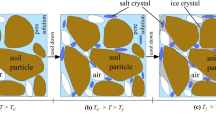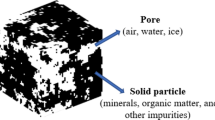Abstract
Soil thermal conductivity has an important role in geo-energy applications and heat transfer modelling. The performances and efficiencies of such applications are strongly affected by the saturation conditions, especially at the lower saturation, which can negatively affect the soil thermal conductivity. Therefore, it is essential to improve the soil thermal conductivity at lower saturation levels. Here, we investigate the effect of the fillers, soil gradation and the water saturation on the thermal conductivity of sand as an innovative improvement method. The experimental results show a significant improvement in the thermal conductivity at dry and lower saturation degrees and a considerable improvement in the case of full saturation. The improvement in the thermal conductivity is comparatively high in dry state and is decreasing with increase in the saturation. The existing soil thermal conductivity models, which are limited to a specific boundary conditions and soil types, fail to consider the effect of soil filler composite behaviour. Therefore, a mesoscale numerical method is developed to model the change in effective thermal conductivity. The developed model shows a good agreement with the measured thermal conductivity values.














Similar content being viewed by others
References
Sandiford P (1981) Cable backfill materials-state-of-the-art. Proceedings of the Symposium on Underground Cable Thermal backfill, Toronto, pp 3–9
Mozan MA, El-Kady MA, Mazi AA (1997) Advanced thermal analysis of underground power cables. Record of the Fifth International Middle East Power Conference MEPCON'97, Alexandria, pp 506–510
Afa JT (2010) Subsoil temperature and underground cable dis-tribution in Port Harcourt City. Res J Appl Sci Eng Technol 2(6):527–531
de Leόn F, Anders GJ (2008) Effects of backfilling on cable ampacity analyzed with the finite element method. IEEE Transactions on Power Delivery 23(2):537–543
Karahan M, Kalenderli O (2011) Heat transfer-engineering applications. In: V. Vikhrenko (eds.), Coupled Electrical and Thermal Analysis of Power Cables Using Finite Element Method, 205–230
Venuleo S, Laloui L, Terzis D, Hueckel T, Hassan M (2015) Effect of microbially induced calcite precipitation on soil thermal conductivity. Géotechnique Letters 00:1–6
Shrestha D, Hailemariam H, Wuttke F (2016) Enhancement of soil thermal conductivity in dry condition. In: Energy Geotechnics-Proceedings of the 1st International Conference on Energy Geotechnics, ICEGT 2016, https://doi.org/10.1201/b21938-64
Rizvi ZH, Shrestha D, Sattari AS et al (2017) Numerical modelling of effective thermal conductivity for modified geomaterial using lattice element method. Heat Mass Transf. https://doi.org/10.1007/s00231-017-2140-2
Yun TS, Santamarina JC (2007) Fundamental study of thermal conduction in dry soils. Granul Matter 10(3):197–207
Johansen O (1975) Ph.D. diss. Norwegian Univ. of Science and Technol, Thermal conductivity of soils. Trondheim (CRREL draft transl. 637, 1977)
Farouki OT (1981) Thermal properties of soils, CRREL Monograph 81–1, US Army Corps of Engineers, Cold Regions Research and Engineering Laboratory, Hanover, N.H
Côté J, Konrad JM (2005a) A generalized thermal conductivity model for soils and construction materials. Can Geotech J 42:443–458
Lu S, Ren T, Gong Y, Horton R (2007) An improved model for predicting soil thermal conductivity from water content at room temperature. Soil Sci Soc Am J 71:8–14
Mori T, Tanaka K (1973) Average stress in matrix and average elastic energy of materials with misfitting inclusions. Acta Metall 21(5):571–574
Gruescu C, Giraud A, Homand F, Kondo D, Do DP (2007) Effective thermal conductivity of partially saturated porous rocks. Int J Solids Struct 44(3):811–833
El Moumen A, Kanit T, Imad A, El Minor H (2015) Computational thermal conductivity in porous materials using homogenization techniques: numerical and statistical approaches. Comput Mater Sci 97:148–158
Łydżba D, Różański A, Rajczakowska M, Stefaniuk D (2017) Random checkerboard based homogenization for estimating efective thermal conductivity of fully saturated soils. J Rock Mech Geotech Eng 9:18–28
Nikolic M, Ibrahimbegovic A (2015) Rock mechanics model capable of representing initial heterogeneities and full set of 3d failure mechanisms. Comput Methods Appl Mech Eng 290:209–227
Nikolic M, Ibrahimbegovic A, Miscevic P (2015) Brittle and ductile failure of rocks: Embedded discontinuity approach for representing mode i and mode ii failure mechanisms. Int J Numer Methods Eng 102:1507–1526
Nikolic M, Karavelic E, Ibrahimbegovic A, Miscevic P (2017) Lattice element models and their peculiarities. Arch Comput Methods Eng. https://doi.org/10.1007/s11831-017-9210-y
Wuttke F, Sattari AS, Rizvi ZH, Motra HB (2016) Advanced mesoscale modelling to study the effective thermo-mechanical parameter in solid geomaterial. Springer Ser Geomech Geoeng. https://doi.org/10.1007/978-3-319-52773-4_9
Nikolic M, Do XN, Ibrahimbegovic A, Nikolic Z (2018) Crack propagation in dynamics by embedded strong discontinuity approach: Enhanced solid versus discrete lattice model. Comput Methods Appl Mech Eng 340:480–499
Rizvi ZH, Sattari AS, Wuttke F (2016) Numerical analysis of heat conduction in granular geo-material using lattice element method, In Energy Geotechnics-Proceedings of the 1st International Conference on Energy Geotechnics, ICEGT 2016, https://doi.org/10.1201/b21938-58
Sattari AS, Rizvi ZH, Motra HB et al (2017) Meso-scale modeling of heat transport in a heterogeneous cemented geomaterial by lattice element method. Granul Matter 19:66
Fuller WB, Thomsan SE (1907) The laws of proportioning concrete. Trans ASCE 59(2):67–143
ASTM (2008) Standard test method for determination of thermal conductivity of soil and soft rock by thermal needle probe procedure, ASTM 5334–08
IEEE (1992) Guide for soil thermal resistivity measurements. Inst. of Electrical and Electronics Engineers, Inc., New York
Haigh SK (2012) Thermal conductivity of sands. Géotechnique 62(7):617–625
Springel V (2011) Smoothed Particle Hydrodynamics in Astrophysics. ARAA 2010(48):391
Rizvi ZH, Khan MA, Wuttke F, Ahmad J (2018) Effective physical parameter evaluation of shallow crustal rocks by lattice element method. ICAMME2018, International Conference on Materials and Manufacturing Engineering, Materials Today: Proceedings
Sattari AS, Motra HB, Rizvi ZH, Wuttke F (2018) A new lattice element method (LEM) with integrated interface elements for determining the effective thermal conductivity of rock solids under thermo-mechanical processes. International Symposium on Energy Geotechnics (SEG), Lausanne
Yovanovich MM (1973) Apparent conductivity of glass microspheres from atmospheric pressure to vacuum. ASME Paper 73-HT-43, American Society of Mechanical Engineers
Kennard EH (1938) Kinetic Theory of Gases. McGraw-Hill, New York
Masamune S, Smith JM (1963) Thermal conductivity of beds of spherical particles. I & EC Fundamentals 2(2):136–143
Askari R, Taheri S, Hejazi SH (2015) Thermal conductivity of granular porous media: A pore scale modeling approach. AIP Adv 5:097106. https://doi.org/10.1063/1.4930258
Bauer R, Schlünder EU (1978) Effective radial thermal conductivity of packings in gas flow. Part II. Thermal conductivity of the packing fraction without gas flow. Int Chem Eng 18:189–204
Acknowledgements
This research project is financially supported by the research grant ZF4016802HF5 and 03G0866B (GeoMInt), provided by the Federal Ministry of Education and Research, Germany.
Author information
Authors and Affiliations
Corresponding author
Additional information
Publisher’s Note
Springer Nature remains neutral with regard to jurisdictional claims in published maps and institutional affiliations.
Rights and permissions
About this article
Cite this article
Shrestha, D., Rizvi, Z.H. & Wuttke, F. Effective thermal conductivity of unsaturated granular geocomposite using lattice element method. Heat Mass Transfer 55, 1671–1683 (2019). https://doi.org/10.1007/s00231-018-02544-3
Received:
Accepted:
Published:
Issue Date:
DOI: https://doi.org/10.1007/s00231-018-02544-3




